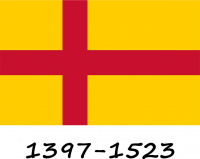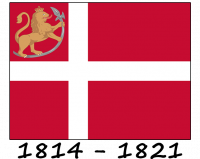Scandinavia at the beginning of the 14th century was characterized by conflicts and political rivalry between three states: Norway, Sweden, and Denmark. The period from 1380 to 1395 was dominated by rivalries and wars between dynasties. The tension was eased by the creation of the Kalmar Union, which united the three kingdoms under one monarch. The prerequisite for this was Queen Margaret I's adoption of her great-nephew Erik of Pomerania in 1387, and later she initiated the creation of the Kalmar Union by electing Erik king of Norway. To consolidate the union, a congress of three state councils and magnates was convened in Kalmar in 1397, at which Eric was elected king of all three kingdoms. This marked the beginning of the Union of Kalmar.
During the first years of the Kalmar Union, conflicts and disagreements arose. Opposition to the act of unification was expressed by Margaret I, who opposed the preservation of the unique laws and customs of each country. There were also many disputes between the three Rigsrads. Despite this, there were no conflicts between the monarch and the Swedish and Danish nobility. Modern scholars believe that the Kalmar Union was created as a means of blocking German expansion to the north. However, the union was not very successful, and constant conflicts led to the Engelbreckt uprising and the fall of King Erik. All these tensions and conflicts created a picture of the fragility and instability of the Kalmar Union, which ultimately could not last long.

There is only one reference to the appearance of the Kalmar Union flag, namely in one of Eric of Pomerania's letters dated 1430, which describes it as "a red cross on a yellow background." The fall of the Union of Kalmar began with the rebellion of Gustavus Vasa against King Christian II, which led to the conquest of most of Sweden. In 1523, he became king of Sweden and effectively ended the union, after which Sweden officially withdrew from it.
At the end of February 1814, Norway designed its first flag, based on the Danish flag, but with the Norwegian national lion in the upper corner. This flag was to be both a state flag, for use in the navy and in fortresses, and a commercial flag, the so-called stutflag, used by merchant ships and private individuals.

1814 was a year of significant changes in the history of Norway. The country, which had previously been ruled by Denmark, became a constitutional monarchy in an alliance with Sweden. The Norwegian "lion flag" could not remain the national flag in the context of the Norwegian-Swedish union. Norwegian patriots drew up an agreement with the King of Sweden, according to which Norway became independent in an alliance with Sweden. The Swedish government controlled diplomatic relations and foreign affairs, but this was not enshrined in the constitution. Swedish kings have always sought a stronger union with Norway, while the Norwegian people have sought to weaken this union, having their own ideas and desires.
The Swedish-Norwegian union used a special sign known as the "Union Sign" (in Swedish: "Unionsmärket", in Norwegian: "Unionstegnet"). It was created in 1844 by King Oscar I to symbolize the unification of the two kingdoms. The Union Jack consisted of the superimposed blue and yellow Swedish and red, white and blue Norwegian flags.

Each country had its own national flag, but with the addition of this symbol in the upper left corner (canton):
- The Swedish flag: Yellow cross on a blue field, with the Union Jack placed in the canton;
- Norwegian flag: A blue cross bordered by white on a red field, with the Union Jack placed in the canton;
- The union naval and diplomatic flag of Norway and Sweden: In addition to being attached to the canton, the union symbol was also used as a separate, independent flag.
Sweden, as the dominant partner in the Swedish-Norwegian union, retained the symbols of the union, including the union flag, for a long period of time, until the union dissolved. Norway was long dissatisfied with its position in the Swedish-Norwegian union, as it believed that Sweden had undue influence on union policy. In 1898, the Norwegian parliament (Storting) passed a law that allowed Norway to use its own national flag without the union symbol (Unionsmärket). The law entered into force on January 1, 1899, after which Norway officially abandoned the use of the Union Flag on its government and merchant ships, retaining only its national flag. In 1905, Norway declared independence from Sweden.
Norwegian national flag contest
In 1821, Norway, which at that time was in a union with Sweden, decided to create its own national flag to reflect its identity, so the Norwegian parliament announced a competition for a new national flag. Letters were received with proposals for a red, white, and blue flag, and some for a black and green flag. The Storting discussed the proposals for a long time, but did not come to an agreement. Opinions on the symbol were divided into two options: the flag should have a lion or a Scandinavian cross.
Here are some of the proposed flag designs, of which there were 18 in total:

Fredrik Meltzer, a merchant and politician from Bergen, proposed a version with a red cloth, a white cross, and a blue cross inside the white. He believed that the proposed red and white version was too similar to the Danish flag, and that it would be too difficult to draw a lion on the flag, as flags were made by hand at that time. According to Meltzer, his version would symbolize not only Norwegian heritage but also unity with other Scandinavian countries, including Sweden and Denmark. The parliament liked the proposal, and it was elected by 40 votes out of 59, and later approved by King Carl Johan.
The flag was officially approved on July 17, 1821 and became the national flag of Norway. This flag is still in use today, symbolizing independence, national unity and Norwegian identity.












